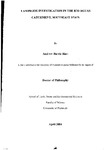LANDSLIDE INVESTIGATION IN THE RÍO AGUAS CATCHMENT, SOUTHEAST SPAIN
| dc.contributor.author | Hart, Andrew Barrie | |
| dc.contributor.other | School of Geography, Earth and Environmental Sciences | en_US |
| dc.date.accessioned | 2013-10-08T12:33:51Z | |
| dc.date.available | 2013-10-08T12:33:51Z | |
| dc.date.issued | 2004 | |
| dc.identifier | NOT AVAILABLE | en_US |
| dc.identifier.uri | http://hdl.handle.net/10026.1/2097 | |
| dc.description.abstract |
Many remote and/or rural communities Uve under the threat of major landslide activity. These remote areas are also increasingly the focus of development programmes which, without careful consideration of the ground conditions, will be at risk. The cost of mitigating against landslide activity can also be extremely high, possibly making prevention or avoidance the better long-term option. It is, therefore, of prime importance to assess the type and magnitude of the landslide activity affecting an area, particularly during the feasibility and planning stages of any project. The most straightforward approach to any landslide investigation is the compilation of a landslide inventory and the development of a geological and geomorphological ground mode! for the area under investigation. Previous landslide inventory-based projects (for example, in UK, Hong Kong and Nepal) have utilised either desk study or remotely sensed sources (aerial photographs or satellite imagery) with only limited field mapping, have focused on wet monsoonal environments in either mountainous and/or heavily populated areas and have usually been completed without reference to a ground model for the area being investigated. Therefore, an investigation of the landslide activity affecting the 425 km² Rio Aguas Catchment area has been completed. This is a remote and rural part of southeastern Spain, which has an arid to semi-arid climate and is periodically affected by both earthquake and flash-flood activity. Through a combination of aerial photographic interpretation (API) and field verification and mapping, over 300 landslides have been mapped and documented. These data have been used to develop a landslide inventory and a conceptual geological and geomorphological ground model of the study area, with respect to the landslide activity. The landslide inventory data have been used to complete a statistical analysis investigating the factors that control the distribution, style and mechanisms of the landslide activity, as well as to examine the relationships between landslide volume, runout length and angle of reach. The basis of the ground model is a project-derived terrain classification for the study area. The data analysis has shown that although a variety of landslide failure mechanisms are seen within the study area, the majority of the landsides are rock falls and topples and/or occur within incised sections of the drainage network. The analysis has also shown that the landslide activity is controlled by a combination of the discontinuities within the rock mass, as well as contrasts in the permeability and stiffness of the rock masses/types involved. The influence of human activity, as well as tectonic activity, rainfall and expansive day soils has also been considered. However, a lack of detailed historical landslide and rainfall data limits the conclusions that can be drawn. The mapped landslide distribution (supported by the geological and geomorphological ground model) has highlighted that the majority of the landslides in the Rio Aguas Catchment are related to a major river capture and modification of the drainage network that occurred approximately 100Ka BP, and that they are a key component of the geomorphological processes active within the study area. This river capture, driven by differential tectonic uplift between sedimentary basins, has caused a wave of incision to pass through a substantial section of the south central part of the study area leading to the oversteepening of slopes, the incision of the drainage network and the majority of the landslide activity that is seen within the study area. The development of the drainage network has been recorded by a series of river terrace deposits that reflect the overall tectonically induced incision as well as the variable Quaternary climate. These river terrace deposits have been used to provide a relative temporal framework for the landslide activity, in the absence of any dated landslide chronology. | en_US |
| dc.language.iso | en | en_US |
| dc.publisher | University of Plymouth | en_US |
| dc.title | LANDSLIDE INVESTIGATION IN THE RÍO AGUAS CATCHMENT, SOUTHEAST SPAIN | en_US |
| dc.type | Thesis | |
| plymouth.version | Full version | en_US |
| dc.identifier.doi | http://dx.doi.org/10.24382/4120 | |
| dc.identifier.doi | http://dx.doi.org/10.24382/4120 |
Files in this item
This item appears in the following Collection(s)
-
01 Research Theses Main Collection
Research Theses Main


